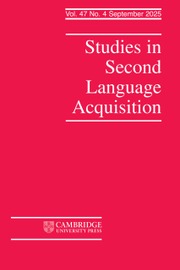No CrossRef data available.
Article contents
THE HUMAN SEMANTIC POTENTIAL: SPATIAL LANGUAGE ANDCONSTRAINED CONNECTIONISM.Terry Regier. Cambridge, MA: MITPress, 1996. Pp. xvi + 220. $37.50 paper.
Published online by Cambridge University Press: 01 December 1997
Abstract
The semantic potential referred to in the title of this book is the ability of humans to learn the(closed-class) terms for basic spatial relations, such as (for English) onto, above, andthrough. Regier presents a modified connectionist model of this ability designed toaddress three questions: (a) What kind of system can learn spatial terms? (b) How can thissystem function without negative evidence? and (c) What are the universal constraints onlearnable spatial terms? The answers suggested to these questions are: (a) a modifiedconnectionist network—one which incorporates structural constraints motivated by humanphysiology; (b) the assumption of mutual exclusion, that is, that different terms have mutuallyexclusive denotations; and (c) the structural constraints that are incorporated into thenetwork.
Information
- Type
- BOOK NOTICES
- Information
- Copyright
- 1997 Cambridge University Press

